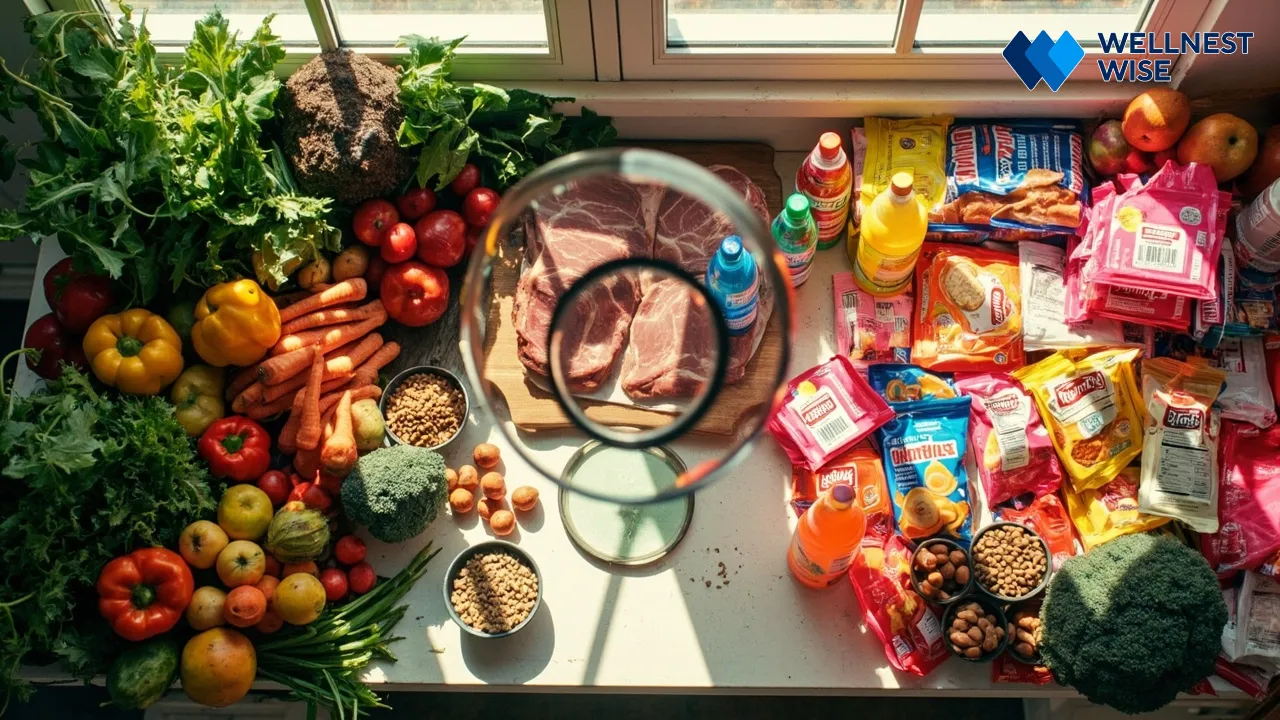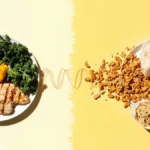It’s 2024, and the whisper of groundbreaking research around our food choices is growing louder. Imagine a future where the exact ways our daily meals impact our bodies are revealed with unprecedented clarity. By 2025, anticipated clinical trials on Ultra-Processed Foods (UPFs) promise to deliver just that, offering latest insights into their profound health impact. These studies are set to redefine our understanding of what we eat and how it shapes our well-being. Join us as we explore what these trials might uncover and how they could transform your plate.
Deciphering Ultra-Processed Foods: Definition and Classification
Understanding ultra-processed foods isn’t just about spotting a brightly colored package; it’s about grasping the scientific criteria that define them and how they differ from whole, natural ingredients. As food processing research intensifies, a clear classification becomes crucial for both consumers and health professionals. These definitions form the bedrock upon which UPF clinical trials 2025 will build their evidence.

What Exactly Are Ultra-Processed Foods (UPFs)?
At its core, a UPF is a formulation of ingredients, mostly industrial in origin, that are typically not used in culinary preparations. Think of them as food-like substances created for convenience, palatability, and shelf-life, rather than pure nutritional value. They often contain little to no whole food, and their consumption is increasingly linked to UPF health risks.
Defining the Spectrum of Food Processing
The term “processed food” covers a wide spectrum. Minimally processed foods, like pre-cut vegetables or roasted nuts, retain most of their natural properties. However, as we move towards ultra-processing, ingredients undergo multiple industrial stages, transforming their original state to create novel food products. These extensive processes often involve the addition of substances not found in traditional home cooking.
The NOVA Classification System: A Scientific Framework
To bring scientific rigor to this discussion, researchers often utilize the NOVA classification system. Developed by a team in Brazil, NOVA categorizes foods into four groups based on their nature, extent, and purpose of processing, providing a universally accepted food processing levels framework.
Understanding Food Processing Levels and Their Implications
- Group 1: Unprocessed or Minimally Processed Foods: Fruits, vegetables, nuts, meats, eggs, milk, water. These are foods in their natural state or processed to preserve them without altering their nutritional properties (e.g., freezing, drying).
- Group 2: Processed Culinary Ingredients: Oils, butter, sugar, salt. These are substances extracted from Group 1 foods used in home and restaurant cooking.
- Group 3: Processed Foods: Breads, cheeses, canned vegetables, salted nuts. These are relatively simple products made by adding Group 2 ingredients to Group 1 foods.
- Group 4: Ultra-Processed Foods (UPFs): The most concerning category, characterized by industrial formulations, often high in sugar, unhealthy fats, and sodium, with added chemicals, emulsifiers, and flavor enhancers.
This framework is critical for designing and interpreting UPF clinical trials, allowing researchers to precisely categorize the dietary intake of participants.
Common Characteristics of Ultra-Processed Products
Beyond the NOVA system, ultra-processed products share discernible traits. They are typically high in calories, low in nutrient density, and packed with sensory appeal. Their convenience and aggressive marketing make them ubiquitous in modern diets.
Key Ingredients and Food Additives to Note
Many UPFs are recognized by their ingredient lists, which often feature:
- Added Sugars: High-fructose corn syrup, glucose syrup.
- Unhealthy Fats: Hydrogenated oils, trans fats.
- Sodium: Often in high amounts, acting as a preservative and flavor enhancer.
- Flavor Enhancers: Monosodium glutamate (MSG).
- Emulsifiers: Carboxymethylcellulose, polysorbate 80.
- Artificial Colors and Sweeteners: Tartrazine, sucralose.
These food additives are industrial compounds that can alter the texture, taste, and shelf life of products, but their long-term ultra-processed food effects on human health are a primary focus of ongoing research.
The Scientific Gaze: Unveiling UPF Impacts Through Clinical Trials
The scientific community is keenly focused on understanding the precise ultra-processed food effects on human health. With 2025 UPF clinical trials on the horizon, researchers are employing rigorous methodologies to move beyond observational correlations and identify causal links. This deep dive into controlled environments promises to yield critical data.

The Power of Randomized Controlled Trials (RCTs) in Nutrition Science
When it comes to establishing cause and effect, randomized controlled trials (RCTs) are considered the gold standard in nutrition science. Participants are randomly assigned to different diet groups—for example, a diet rich in UPFs versus a minimally processed diet—and their health outcomes are meticulously tracked. This controlled approach minimizes bias and strengthens the validity of findings regarding UPF health risks.
Why RCTs are Pivotal for Robust UPF Research
Unlike observational studies that can only suggest associations, RCTs allow researchers to manipulate variables and measure direct outcomes. For ultra-processed food clinical trials, this means designing diets where the only significant variable is the level of processing, enabling scientists to isolate the ultra-processed food effects from other lifestyle factors.
Anticipated Breakthroughs from 2025 UPF Clinical Trials
The year 2025 is poised to bring forth significant revelations from ongoing and newly launched UPF clinical trials. These studies aim to clarify long-standing questions about how extensively processed foods interact with our bodies, potentially highlighting new UPF health risks.
Key Research Questions and Emerging Hypotheses
- Weight Management: Do UPFs inherently promote overconsumption and weight gain, independent of caloric content? Initial evidence suggests they might, by affecting satiety signals.
- Metabolic Health: How do UPFs directly contribute to metabolic syndrome and insulin resistance?
- Gut Health: What are the specific mechanisms by which UPFs disrupt the gut microbiome health?
- Inflammation: Do certain food additives or processing byproducts directly trigger systemic inflammation markers?
These questions are guiding researchers toward targeted investigations that will provide unprecedented detail.
Expected Findings on Specific Health Outcomes and UPF Health Risks
While specific results from 2025 trials are still anticipated, researchers expect to see clearer links between UPF consumption and:
- Cardiovascular disease: Through impacts on blood pressure, cholesterol, and arterial health.
- Type 2 Diabetes: By affecting glucose metabolism and insulin sensitivity.
- Certain Cancers: As inflammation and gut dysbiosis are recognized cancer promoters.
- Mental Health: Emerging research points to connections between diet quality and mood disorders.
These findings will be crucial for informing future dietary guidelines UPF.
Measuring the Impact: Bio-markers and Outcome Assessment
To objectively assess the ultra-processed food effects, scientists rely on a range of measurable biological indicators, or bio-markers. These tools help quantify changes within the body that might not be immediately visible.
Critical Bio-markers for Metabolic and Inflammatory Responses
Researchers in UPF clinical trials will be closely monitoring:
- Glucose and Insulin Levels: To assess metabolic control.
- Lipid Profiles: Including total cholesterol, LDL, HDL, and triglycerides, relevant to cardiovascular health.
- C-Reactive Protein (CRP) and Interleukins: Key inflammation markers indicating systemic inflammation.
- Gut Microbiome Composition: Analyzing bacterial diversity and specific strains to understand changes in gut microbiome health.
- Appetite-Regulating Hormones: Such as ghrelin and leptin, to understand satiety signals.
These detailed assessments provide the scientific backbone for understanding the comprehensive health burden of UPFs. For instance, a small-scale pilot study recently showed that even a short period (two weeks) of consuming an ultra-processed diet led to increased caloric intake and weight gain compared to a minimally processed diet, even when calories were matched. This underscores the subtle yet significant ultra-processed food effects on appetite regulation.
The Comprehensive Health Burden of Ultra-Processed Foods
The impact of ultra-processed foods extends far beyond simple weight gain; it permeates multiple physiological systems, contributing to a significant health burden. As food processing research advances, we’re gaining a more complete picture of how these foods contribute to chronic diseases and diminish overall well-being. This understanding is paramount for chronic disease prevention.

Exploring the Link Between UPFs and Chronic Disease Prevention
The connection between what we eat and our long-term health is undeniable, and UPFs are increasingly implicated in the rise of non-communicable diseases. The anticipated 2025 trial findings are expected to solidify these links, providing clearer evidence for their role in chronic illness.
Cardiovascular Health and Metabolic Syndrome Risks
High consumption of UPFs is consistently associated with increased risks of cardiovascular disease. These foods often contain high levels of added sugars, unhealthy fats, and sodium, which are known culprits in elevating blood pressure, increasing “bad” cholesterol (LDL), and contributing to inflammation. All these factors are components of metabolic syndrome, a cluster of conditions that dramatically raises your risk for heart disease, stroke, and type 2 diabetes.
The Role in Type 2 Diabetes Development and Progression
The rapid absorption of sugars from UPFs leads to sharp spikes in blood glucose and insulin. Over time, this constant demand on the pancreas can lead to insulin resistance, a precursor to Type 2 Diabetes. Furthermore, some food additives found in UPFs may directly impair glucose metabolism, further accelerating the disease’s onset and progression.
The Gut Microbiome: A Key Target for Ultra-Processing
Our gut is a complex ecosystem, home to trillions of microorganisms that play a vital role in digestion, nutrient absorption, and immune function. Ultra-processed food effects on this delicate balance are a major area of concern in food processing research.
How UPFs Disrupt Gut Microbiome Health and Immune Function
Many UPFs are devoid of fiber, a crucial nutrient for feeding beneficial gut bacteria. Instead, they often contain artificial sweeteners and emulsifiers that can negatively alter the composition and function of the gut microbiome. This dysbiosis—an imbalance in gut bacteria—can lead to increased intestinal permeability, allowing harmful substances to leak into the bloodstream, triggering systemic inflammation and compromising immune function. This, in turn, may contribute to a range of health issues, from allergies to autoimmune conditions.
Impact on Inflammation Markers and Systemic Health
The disruption of the gut microbiome, coupled with the inflammatory potential of certain food additives and high sugar content, contributes to elevated inflammation markers throughout the body. Chronic low-grade inflammation is a silent driver of many chronic diseases, including heart disease, cancer, and neurodegenerative disorders. The UPF clinical trials aim to precisely quantify these inflammatory responses.
Uncovering Other Adverse Effects: From Mental Well-being to Nutrient Density
The ramifications of a diet rich in UPFs extend beyond physical health, touching cognitive function and emotional balance, while also raising concerns about overall nutrient density.
Beyond Physical Health: Cognitive and Mood Implications
Emerging evidence suggests a strong link between diet quality and mental health. UPFs, with their pro-inflammatory and gut-disrupting properties, may negatively affect brain function and mood. Studies have shown associations between high UPF intake and increased risks of depression, anxiety, and poorer cognitive performance. The mechanisms are complex, involving effects on neurotransmitter production and brain inflammation, which 2025 trials hope to elucidate further.
The Challenge of Nutrient Density in UPF-Rich Diets
One of the fundamental problems with UPFs is their lack of essential vitamins, minerals, and fiber, despite being calorie-dense. A diet heavily reliant on these products often means a diet lacking in overall nutrient density. This “empty calorie” intake can lead to micronutrient deficiencies, even in individuals consuming sufficient calories, compromising long-term health and contributing to a range of subtle but significant health issues.
Translating Science into Action: Future Dietary Guidelines and Informed Choices
As the scientific evidence from ultra-processed food clinical trials continues to mount, especially with the anticipated findings from 2025 UPF clinical trials, a critical shift is expected in how we approach nutrition. This knowledge is vital for evolving dietary guidelines UPF and empowering individuals and policymakers to make truly informed decisions for public health.

Evolving Dietary Guidelines: Integrating UPF Research
For decades, dietary guidelines have focused on nutrients like fat, sugar, and sodium. However, the paradigm is shifting. The emphasis is moving towards the degree of processing as a crucial factor in diet quality. This means that recommendations might soon clearly distinguish between a natural source of sugar (like fruit) and added sugars in a UPF, even if their nutrient profiles seem superficially similar.
How Anticipated 2025 Findings Could Reshape Recommendations
The robust evidence expected from 2025 UPF clinical trials, particularly from randomized controlled trials (RCTs), is poised to provide direct causality. This could lead to:
- Explicit UPF Reduction Goals: Official guidelines may include specific recommendations to limit or avoid UPFs, rather than just focusing on individual nutrients.
- Clearer Consumer Education: Public health campaigns could be developed to help consumers identify ultra-processed foods and understand their broader health impact.
- Policy Initiatives: Governments might consider policies similar to those for tobacco, introducing labeling requirements or restrictions on marketing to children.
These shifts would represent a significant step forward in recognizing the ultra-processed food effects on a population level.
Empowering Informed Decisions for Public Health
Equipping individuals with the knowledge to discern healthy choices from unhealthy ones is a cornerstone of public health. Understanding the science behind UPFs enables people to make better decisions for themselves and their families.
Understanding Nutritional Epidemiology and Its Role in Policy
Nutritional epidemiology studies the relationship between diet and health in populations. While vital for identifying trends and associations, UPF clinical trials provide the crucial experimental data. This combined evidence forms the basis for effective public health policy. Policy makers, health organizations, and even school systems need this comprehensive understanding to implement changes that genuinely promote well-being.
The Societal Challenge: Promoting Healthier Food Environments
Changing individual dietary habits is challenging in an environment saturated with cheap, convenient, and highly palatable UPFs. Addressing the societal drivers of UPF consumption requires a multi-faceted approach.
Policy Implications and Food System Transformation for Better Health
Effective strategies will likely include:
- Taxation on UPFs: To make healthier options more affordable.
- Restrictions on Marketing: Especially to vulnerable populations like children.
- Subsidies for Whole Foods: To increase access and affordability of fruits, vegetables, and other minimally processed items.
- Reformulation of Products: Encouraging manufacturers to reduce sugar, salt, and unhealthy fats, and eliminate problematic food additives.
- Public Education Campaigns: To raise awareness about UPF health risks and provide practical guidance.
Ultimately, achieving better health outcomes requires not just individual effort, but a systemic food system transformation driven by scientific understanding and strong public health policies.
Practical Steps for a Healthier Plate: Reducing UPF in Your Diet
The scientific data, even before the full results of 2025 UPF clinical trials are in, strongly suggests that reducing ultra-processed foods is a powerful step toward better health. Translating this knowledge into daily action can seem daunting, but with a few practical strategies, you can significantly improve your diet and embrace a lifestyle of chronic disease prevention.

Identifying and Limiting Common UPFs in Daily Life
The first step is awareness. Learning to spot ultra-processed foods will empower you to make more deliberate choices. These products are often designed for maximum appeal and convenience, but a closer look at their origins and ingredients reveals their true nature.
- Sugary Beverages: These are classic UPFs with minimal nutritional value. Think:
- Soft drinks
- Sweetened juices
- Energy drinks
- Packaged Snacks: Designed for quick consumption and often laden with unhealthy fats and sugars. Examples include:
- Chips
- Cookies
- Candy bars
- Most commercial pastries
- Instant Meals: While convenient, these are typically packed with sodium and lacking in fresh ingredients. Look out for:
- Instant noodles
- Microwaveable dinners
- Dehydrated soups
- Processed Breakfast Cereals: Many of these are heavily sweetened and fortified with synthetic vitamins, masking their highly processed nature:
- Many pre-sweetened breakfast cereals
- Fortified, puffed grain cereals
- Processed Meats: Often contain a range of food additives, sodium, and unhealthy fats:
- Hot dogs
- Sausages
- Deli meats
- Bacon
- Sweetened Dairy Products: While dairy can be nutritious, many flavored versions fall into the UPF category due to added sugars and artificial ingredients:
- Flavored yogurts
- Ice cream
- Sweetened milk alternatives
Reducing these items doesn’t mean eliminating them overnight, but rather making conscious efforts to choose alternatives.
Smart Shopping: Navigating the Supermarket
The supermarket can feel like a minefield of UPFs, but with a few strategies, you can successfully fill your cart with wholesome options. It’s about being an educated consumer.
Tips for Reading Food Labels and Ingredient Lists Effectively
- Focus on the Ingredient List: This is your best guide. Look for short lists with recognizable ingredients. If you see a long list of chemical-sounding names, high-fructose corn syrup, or hydrogenated oils, it’s likely a UPF.
- Beware of Health Claims: Words like “natural,” “healthy,” or “fortified” on the front of a package can be misleading. Always turn to the ingredient list and nutrient density information.
- Check Serving Sizes: Be mindful that nutritional information is often based on small serving sizes that might not reflect typical consumption.
Prioritizing Whole and Minimally Processed Foods for Nutrient Density
Aim to spend most of your shopping time in the perimeter of the grocery store, where fresh produce, lean meats, dairy, and seafood are typically found. These are the cornerstones of a diet rich in nutrient density. Filling your plate with whole foods ensures you’re getting essential vitamins, minerals, and fiber without the hidden food additives and empty calories of UPFs.
Culinary Empowerment: Cooking at Home and Healthy Alternatives
One of the most effective ways to reduce UPF health risks is to reclaim your kitchen. Cooking at home gives you full control over ingredients, allowing you to prioritize fresh, whole foods.
UPF Swaps for a Healthier Diet
Making simple swaps can significantly reduce your UPF intake without feeling deprived.
| Common Ultra-Processed Food Item | Healthier Whole Food Alternative |
|---|---|
| :——————————- | :——————————- |
| Sugary Soda | Water with lemon/cucumber infusion |
| Packaged Breakfast Cereal | Rolled oats with fresh fruit and nuts |
| Instant Noodles | Homemade vegetable or lentil soup |
| Pre-packaged Snacks (e.g., chips) | Fresh fruit, handful of almonds, plain yogurt |
| Processed Deli Meats | Grilled chicken breast, baked salmon, legumes |
“After consistently opting for homemade meals and swapping my usual afternoon cookie for an apple with a handful of almonds, I noticed a significant change,” shares Sarah, a client who recently transitioned away from a UPF-heavy diet. “My energy levels are more stable, and I no longer experience that afternoon slump. It feels like I’m finally nourishing my body properly.” This personal experience underscores the immediate benefits of simple dietary changes.
Sustaining Change: Building Healthy Eating Habits
Sustainable change doesn’t happen overnight. It’s a gradual process of building new habits and being mindful of your choices.
Gradual Transitions and Mindful Eating Practices
Start small. Perhaps choose one meal a day to make from scratch, or replace one UPF snack with a whole-food alternative. Practice mindful eating, paying attention to your body’s hunger and fullness cues, and savoring the flavors and textures of your food. This approach can help you recognize the true satisfaction that comes from nutrient-dense foods, making the transition away from UPFs feel more natural and enjoyable. Remember, every small step contributes to a larger journey toward better health and chronic disease prevention.
Conclusion & Takeaways
The landscape of nutrition science is continually evolving, and Ultra-Processed Food Clinical Trials 2025 are set to be a pivotal moment. We’ve explored how UPFs are defined, the scientific rigor of randomized controlled trials (RCTs), and the anticipated breakthroughs that will further illuminate the profound health impact of these industrial food products. From their links to metabolic syndrome and chronic disease prevention to their disruption of gut microbiome health and influence on mental well-being, the ultra-processed food effects are far-reaching.
As dietary guidelines UPF continue to integrate this burgeoning research, the call for informed decisions for public health grows stronger. The evidence empowers us to make healthier choices, armed with practical strategies for identifying and reducing UPFs in our daily lives through smart shopping and culinary empowerment. While the full scope of 2025’s findings is yet to be revealed, the existing and anticipated science undeniably points towards a healthier future rooted in whole, minimally processed foods. Embrace this knowledge, transform your plate, and join the movement towards a more vibrant, well-nourished life.
FAQ
Practical, scientific Q&A
What specific health outcomes are 2025 UPF clinical trials expected to focus on?
2025 UPF clinical trials are anticipated to provide in-depth insights into their effects on various health outcomes, primarily focusing on metabolic syndrome, cardiovascular health, Type 2 Diabetes development, gut microbiome health, and systemic inflammation markers. There’s also growing interest in cognitive function and mental well-being, aiming to establish clearer causal links through rigorous randomized controlled trials (RCTs).
How does the NOVA classification system help in understanding Ultra-Processed Foods?
The NOVA classification system categorizes foods based on the extent and purpose of their processing, rather than just nutrient content. This allows researchers and consumers to differentiate between minimally processed foods (like fresh fruit) and ultra-processed foods (like sugary cereals), providing a standardized framework for food processing research and for understanding potential UPF health risks beyond individual nutrient analyses.
Can reducing UPF intake really improve my gut microbiome health?
Yes, absolutely. Ultra-processed foods are typically low in fiber and often contain food additives like emulsifiers and artificial sweeteners that can negatively alter the diversity and function of your gut microbiome. By replacing UPFs with whole, minimally processed foods rich in fiber (fruits, vegetables, legumes, whole grains), you provide essential nourishment for beneficial gut bacteria, which can significantly improve gut microbiome health and overall immune function.
What role do “bio-markers” play in UPF clinical trials?
Bio-markers are measurable biological indicators (e.g., blood glucose, inflammatory proteins like CRP, gut microbial composition) that scientists use in UPF clinical trials to objectively assess the body’s response to different diets. They provide concrete evidence of ultra-processed food effects on various physiological systems, helping to quantify changes in metabolic syndrome risk, inflammation, and other health parameters.
Are all processed foods considered harmful, or just ultra-processed ones?
No, not all processed foods are harmful. The key lies in the degree of processing, as highlighted by the NOVA classification system. Minimally processed foods (e.g., frozen vegetables, roasted nuts, whole-grain bread) are generally beneficial and retain most of their nutritional value. It is the ultra-processed foods—industrial formulations with many food additives, high in sugar, unhealthy fats, and sodium, and low in nutrient density—that are consistently linked to adverse UPF health risks and are the primary focus of concerns and food processing research.














